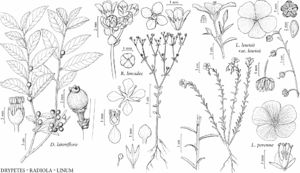Linum perenne
Sp. Pl. 1: 277. 1753.
Herbs, perennial, 20–100 cm, glabrous. Stems ascending or erect, usually unbranched. Leaves: blade linear or linear-lanceolate, 5–20 × 1–3 mm. Inflorescences much-branched panicles. Pedicels spreading, 5–25 mm. Flowers heterostylous; inner sepals ovatelanceolate or ovate, 4.5–5.5 mm, margins glabrous, apex obtuse, outer ones lanceolate or ovatelanceolate, 3.5–4.5 mm, narrower than inner ones, margins glabrous, apex acute or acuminate; petals blue, obovate or obovate-lanceolate, 10–25 mm; stamens 5 mm, anthers 2 mm (long-styled morph) or stamens 6.5 mm, anthers 1.8 mm (short-styled morph); styles distinct, 8 mm (long-styled morph) or 2.5 mm (short-styled morph); stigmas capitate. Capsules subglobose, 5–7 mm diam., apex acute to obtuse, segments persistent on plant, margins ciliate or not. Seeds 3–4.2 × 1.7–2 mm. 2n = 18.
Phenology: Flowering Mar–Aug.
Habitat: Disturbed areas.
Elevation: 100–1000 m.
Distribution

Introduced; B.C., Ont., Yukon, Ariz., Colo., Idaho, Ill., Iowa, Maine, Mich., Mont., Nebr., Nev., N.Y., Ohio, Oreg., Pa., Utah, Va., W.Va., Wis., Eurasia, also in Mexico (Sonora)
Discussion
Most collections in North America identified as Linum perenne are most likely L. lewisii var. lewisii (D. J. Ockendon 1971; C. M. Rogers 1984). According to Ockendon, L. perenne is often confused with L. austriacum Linnaeus in Europe; its exact native distribution is not known.
Selected References
None.
Lower Taxa
"narrower" is not a number."wider" is not a number.
